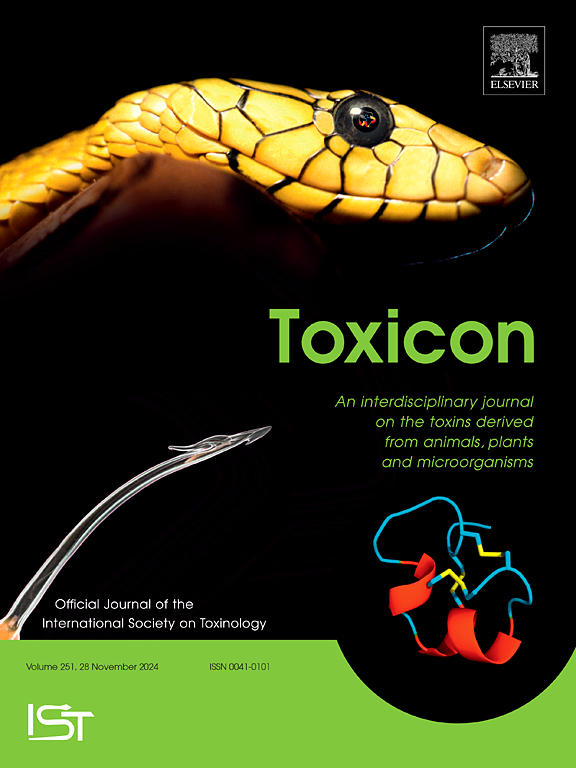巴西食用再生高粱属肉牛后代脊髓的关节挛缩和轴突病
IF 2.6
4区 医学
Q2 PHARMACOLOGY & PHARMACY
引用次数: 0
摘要
高粱相关的关节挛缩和轴索病是一种罕见的先天性疾病报道在反刍动物和马。在这里,我们描述了2014-2023年巴西中西部和东南部9次牛瘟暴发的流行病学、临床和病理学方面的情况。这些地区是谷物高粱产量最高的地区,牲畜生产者广泛使用秸秆,在干旱期间再生率很高。所有受影响的怀孕奶牛都吃过高粱秸秆,时间从25天到4个月不等。她们在妊娠晚期和中期流产,或生下的小牛伴有关节挛缩,四肢过屈或过伸。未见其他肉眼病变。在4只死于不同爆发的小牛中,典型的神经组织学病变包括颈脊髓背角和腹角灰质中的少量到大量轴突球体。超微结构上,退化轴突表现为残体和退化细胞器的节段性堆积。牛消耗高粱秸秆和患病小牛的特征性脊髓病变的结合是独特的,并证实了诊断。该地区的高粱消费也与急性中毒和膀胱炎-共济失调综合征有关。在美洲,我们首次报道了一种以肉牛关节挛缩和轴突病为特征的高粱相关先天性综合征。本文章由计算机程序翻译,如有差异,请以英文原文为准。
Arthrogryposis and axonopathy in the spinal cord in offspring of beef cattle grazing regrowth Sorghum spp. in Brazil
Sorghum-associated arthrogryposis and axonopathy is a rare congenital condition reported in ruminants and horses. Here, we describe the epidemiologic, clinical, and pathologic aspects of nine outbreaks of this condition in beef cattle in midwestern and southeastern Brazil (2014–2023). These regions are the most productive grain sorghum areas, where livestock producers use the straw extensively, producing a high regrowth during drought periods. All the affected pregnant cows had grazed sorghum stover for periods ranging from 25 days to 4 months. They showed abortion in the final and middle third of gestation or gave birth to calves with arthrogryposis, with overflexion or overextension of the limbs. No other gross lesions were observed. Typical neurohistologic lesions in four autopsied calves from different outbreaks included scarce to numerous axonal spheroids in the gray matter of the dorsal and ventral horns in the cervical spinal cord. Ultrastructurally, degenerated axons exhibited a segmental accumulation of residual bodies and degenerate organelles. The combination of sorghum stover consumption by the dams and characteristic spinal cord lesions in affected calves is distinctive and confirms the diagnosis. Sorghum consumption in the region was also associated with acute poisoning and cystitis-ataxia syndrome. For the first time in the Americas, we report a sorghum-associated congenital syndrome characterized by arthrogryposis and axonopathy in beef cattle.
求助全文
通过发布文献求助,成功后即可免费获取论文全文。
去求助
来源期刊

Toxicon
医学-毒理学
CiteScore
4.80
自引率
10.70%
发文量
358
审稿时长
68 days
期刊介绍:
Toxicon has an open access mirror Toxicon: X, sharing the same aims and scope, editorial team, submission system and rigorous peer review. An introductory offer Toxicon: X - full waiver of the Open Access fee.
Toxicon''s "aims and scope" are to publish:
-articles containing the results of original research on problems related to toxins derived from animals, plants and microorganisms
-papers on novel findings related to the chemical, pharmacological, toxicological, and immunological properties of natural toxins
-molecular biological studies of toxins and other genes from poisonous and venomous organisms that advance understanding of the role or function of toxins
-clinical observations on poisoning and envenoming where a new therapeutic principle has been proposed or a decidedly superior clinical result has been obtained.
-material on the use of toxins as tools in studying biological processes and material on subjects related to venom and antivenom problems.
-articles on the translational application of toxins, for example as drugs and insecticides
-epidemiological studies on envenoming or poisoning, so long as they highlight a previously unrecognised medical problem or provide insight into the prevention or medical treatment of envenoming or poisoning. Retrospective surveys of hospital records, especially those lacking species identification, will not be considered for publication. Properly designed prospective community-based surveys are strongly encouraged.
-articles describing well-known activities of venoms, such as antibacterial, anticancer, and analgesic activities of arachnid venoms, without any attempt to define the mechanism of action or purify the active component, will not be considered for publication in Toxicon.
-review articles on problems related to toxinology.
To encourage the exchange of ideas, sections of the journal may be devoted to Short Communications, Letters to the Editor and activities of the affiliated societies.
 求助内容:
求助内容: 应助结果提醒方式:
应助结果提醒方式:


